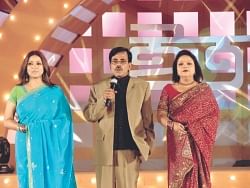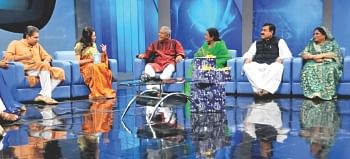| Home - Back Issues - The Team - Contact Us |
 |
| Volume 10 |Issue 35 | September 16, 2011 | |
|
|
Perspective
Where the Sky is Limited While 50 India-controlled satellite television channels are broadcast all over Bangladesh, not a single Bangladeshi satellite channels can be viewed in Indian cities Tamanna Khan Muneera Khan is looking for Sanddhi Sudha, an ointment for aches, advertised on Zee TV, an Indian satellite channel, for which she has to pay a monthly subscription fee to her cable operator. Since Sanddhi Sudha is an Indian product, Khan has to bring it from India sending someone there with dollars. As a result India earns revenue from subscription fee of Zee TV, sale of Sanddhi Sudha and finally from the travelling cost of the buyer. It is not just herbal medicine, thanks to the numerous Indian satellite television channels, fashion, songs, movies — all sorts of consumer goods have made their presence in the home of Bangladeshi viewers. Unfortunately, the same is not true for Bangladeshi products and services. In this era of globalisation, free-trade and open economy, Bangladesh is forced into an unfair competition with its neighbour India. At present around 80 to 90 television channels are broadcast in Bangladesh, out of which twenty are Bangladeshi, including the government-owned terrestrial channel Bangladesh Television (BTV). The rest are foreign language channels, the majority of which are Indian-market based, targeted at an Indian audience. Among these 30-40 are purely Indian channels in different Indian languages including Hindi and Bengali. Most of the Indian satellite channels like those of Star, Sony and Zee group are pay channels. Special receivers are required to downlink the channels and their local distributors pay monthly subscriptions to the broadcasters at a rate approved by the Ministry of Information, Bangladesh. The subscription fee is collected from Bangladeshi viewers through the cable operators. In contrast, not a single of the eighteen Bangladeshi satellite channels (currently in broadcast) is aired in any large city of India, a country with a population of more than 83 million Bengali speaking people. Television channels 'uplinked' from foreign countries need to follow some specific guidelines of the Indian ministry of Information and Broadcasting for 'downlinking' their channels for Indian viewers. The guideline requires the applicant company which can either be a sole distributor of a Bangladeshi broadcaster or a foreign office, to be registered in India under the Indian Companies Act, 1956. The company should have a net worth of Rs 15 million for downlinking one channel and Rs 10 million for every additional channel. As registration fee the company has to pay Rs 5 lakhs for each channel for the initial five years to be renewed at the end of the period. Before signing the Grant of Permission Agreement another Rs 5 lakhs have to be paid to the ministry in addition to Rs 1 lakh per channel as annual fee. The application will also be subject to security clearance from the Indian Ministry of Home Affairs. Thus on pen and paper there is no restriction from the Indian government in allowing the entry of Bangladeshi channels in India. The problem lies elsewhere. Bangladeshi satellite channels are free-to-air (FTA), meaning anyone with appropriate receiving equipment available in the market can receive the signal and view or listen to the content without a subscription fee, explains Ehsan Sarwar Chowdhury, Head of sales and business development, Edu-Smart.info. Ehsan has experience of working in cable operation projects, IPTV (Internet Protocol TV) and the cable distribution wing of a former local distributor of foreign channels. He adds that cable TV operators in the countries under the footprint (the ground area under the coverage of the transmitter-receiver device) of the communication satellite (Apstar 2R) in which most of our channels are uplinked can easily downlink the channels, because they are all FTA. Apstar 2R coverage extends to many countries in Asia, Europe, Africa and Australia. Thus Indian cable operators do not need to bear any extra cost to make our channels available for viewing. Yet Bangladeshi channels cannot be viewed in any major city in India. Pramit Reza, Head of distribution, independent 24.tv states the reason. According to his estimation, there are about 650 international, national and regional television channels in India. “There are two types of delivery networks in India to make these channels available for viewing at household levels. One through cable (wired), the other is wireless. The wired has two segments --- analogue and digital. The wireless is generally called Direct-to-home (DTH). This is wireless digital. Maximum subscribers are under the wired analogue. The bandwidth of the wires has a certain capacity to carry data or video. Theoretically, if you put the best equipment, a maximum 106 channels can be carried. Practically the capacity is limited to 90-95 channels. Whereas there are 650 regional and national channels, each network can only air at best 90 channels. Here supply is six seven times higher than demand. Thus when new channels arrive they offer payments to the cable networks in exchange of carrying their channels,” explains Pramit. This payment is called carriage fee and it is one of the basic barriers for entry into the Indian market.
Dr Mahfuzur Rahman, Chairman and Managing Director of ATN Bangla Limited confirms saying: “The cable operators in India demand a huge amount of money from us. When our Kolkata representative talked with them they asked for a sum of Tk 2-3 crore annually for carrying our channel.” Dr Mahfuz raises the question why Bangladeshi channels should pay so much money to Indian cable operators whereas Indian channels do not pay a dime to our cable operators. Pramit notes that according to a report Rs 1300 crore has been exchanged as carriage fee in India in the last financial year. Not surprisingly, their cable operators are not interested to air our channels for free. According to Nizamuddin Masud, former general secretary of Cable Television Operators' Association of Bangladesh (COAB), four large cable TV operators control the networks in central Kolkata, where majority of Bengali-speakers live, notwithstanding Bangladesh. “We have talked with them and they are not willing to carry our channels without carriage fee,” he says adding that it is not possible for our channels to compete with the local channels of India in this respect. On the other hand paying such insanely large amount also does not make business sense for Bangladeshi satellite channels. Internationally, television channels have two main revenue streams — subscription revenue and advertisement revenue. Pramit cites how the demand created by Bangladeshi Diaspora has made it possible for Bangladeshi satellite channels to earn both subscription and advertisement revenue from the United States (which is beyond Apstar 2R footprint). In the case of India, the FTA status of the Bangladeshi satellite channels prevents them from earning any subscription revenue. “Moreover, we could not create sufficient demand in India to become pay TVs,” he adds. Thus the only revenue stream that can be tapped in India is advertisement. “Our revenue will come from advertisement of Bangladeshi products marketed in India,” says Pramit giving example of Middle East where there is a market for Bangladeshi products among Bangladeshi viewers. Although they too do not pay any subscription fee for our FTA channels they influence the buying decision of their family back home. Local advertisers show interest in sponsoring the programmes to target this population. The same is not true about Indian viewers, whose interest in Bangladeshi products has not been created. On the other hand, advertisement revenue from Indian products also remains farfetched as Indian advertisers can easily reach to the viewers through their own regional and national channels. “So why would they invest their money in channels which are not even tested there?” Pramit inquires referring to Bangladeshi channels' status in India. The scenario is quite different across the border. Not only are we getting to view Indian products in Indian channels but our advertisers are also being lured away by Indian channels complains Dr Mahfuz. Referring to Zee TV's Bengali language programmes, he says, “From 10pm to 11pm they air super flop Bangladeshi dramas that mar the image of Bangladeshi culture. They have brought these dramas at a cheap price and they are trying to collect ad revenues from Bangladesh. Consequently, the local Bangladeshi TV channels will lose revenue by getting fewer advertisements.” He doubts whether Zee TV, like Bangladeshi private channels pays 15% VAT to Bangladesh government on advertisement revenues. “Our Kolkata office in its 4-5 years of establishment could not collect even one single advertisement from Indian companies for our channel. If this is so, then why should we allow our ads to be aired in Indian channels?” says Dr Mahfuz. Shykh Seraj, founder Director and Head of News, Channel i, points out how Bangladeshi satellite channels not only face competition from within the country but also across the border as Bengali-language channels from India are aired in Bangladesh without any restriction. “We are facing unfair competition from channels like Zee Bangla and Tara Bangla. They can air their advertisements in both countries whilst we do not have any access in their country. Why won't our government restrict these channels?” he questions.
Giving the example of how Bangladeshi TV channels promote Bangladeshi products, he emphasises that government has to be strict about Indian channels that has already made Bangladesh a market for Indian products. “When the multinational companies see that Indian programmes have higher TRP at prime time than Bangladeshi programmes, they invest their money in the other side of the border. We are facing one sided competition,” he observes. Besides, Bangladeshi cable TV operators have started imitating their Indian counterparts in charging carriage fee from new channels recently, he informs. He adds that many cable TV operators are also not following the policy guideline of the Ministry of Information where it has been clearly stated that the first 12 channels should carry programmes of Bangladeshi broadcasters only. According to Nizamuddin, there is sufficient demand for Bangladeshi programmes in Indian states with considerable Bengali population. In fact, COAB has arranged with local operators at places like KochBihar, Shiliguri, Jalpaiguri, Malda, Dinajpur and Chabbish Pargana to air ATN Bangla, Channel i and NTV. Nevertheless, the viewership is limited. Recently, the Bangladesh government has signed a memorandum of understanding to exchange programmes of Indian national television Doordarshan and Bangladeshi government television BTV. Chief ministers of Assam, Tripura, Mizoram and Meghalaya accompanying the Indian premier on his recent tour to Bangladesh have stated that they will take steps to air Bangladeshi television channels in their states. Yet the reality appears bleak for Bangladeshi satellite television channels. The inequitable competition also puts a strain on our foreign currency reserve when the amount Bangladesh remits to Indian pay channels is taken into account. Shykh Seraj provides a figure of Tk 2000 crore which is paid annually by local agents to the Indian pay TVs. The government's attempt to restrict the Indian channels in the past has met with huge protest from Bangladeshi viewers. So the next time when we worry about Priya and Ram Kapur's wedding (two Hindi serial characters) or look for Aksara's (another Hindi serial character) saree in our stores, perhaps we should keep the Tk 2000 crore figure in mind.
Copyright
(R) thedailystar.net 2011 |



